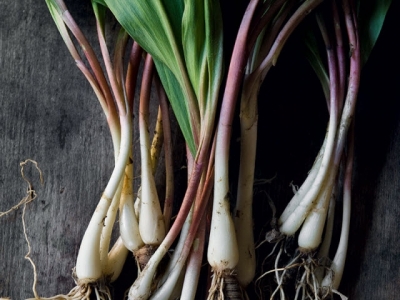Cropped: How to Grow Ramps

Ramps (Allium tricoccum) resemble a more delicate scallion and have a flavor reminiscent of garlic, onions, and leeks.Valery Rizzo
Increasingly rare in the wild, these little onions can be cultivated by any farmer who possesses a bit of forested land and a whole lot of patience
With a sweet pungency that combines the flavors of garlic, scallions, and leeks, ramps (Allium tricoccum) have become something of a rare delicacy as rising demand depletes the natural supply. Unfortunately, harvesting the bulbs—which grow wild in forests from Minnesota to Maine and as far south as Georgia—effectively kills the plants. Even worse, this particular plant can take seven years to reach maturity. It’s why Great Smoky Mountains National Park banned ramp-foraging in 2004, and why horticultural scientists at North Carolina State University have been researching how farmers might help ensure a robust ramp population.
A good portion of the land in the eastern United States is forested and thus too shady for conventional crops—yet ideal for ramps. True, you won’t be able to reap what you sow for five to seven years (three, if you plant bulblets instead of seeds), but you’ll be using otherwise fallow acreage to produce a crop that brings in about $15 a pound.
Growing
Though officially hardy in Zones 3 to 7, ramps require a specific woodland habitat: shady and damp (at least 35 inches of rainfall throughout the year), with well-drained, acidic, calcium-rich soil. These same conditions are favored by trilliums, trout lilies, and mayapples, so if you notice an area where those plants thrive (likely under the shade of beeches, maples, hickories, or oaks), you’ve found the perfect place to cultivate ramps.
Sow seeds in early fall, spacing them 4 to 6 inches apart and pressing them into the soil with the palm of your hand. Or speed up the process by planting bulblets, 2 to 3 inches deep, in early spring, just after the ground has thawed. Either way, mulch with a 2-inch layer of hardwood tree leaves, and use overhead irrigation during dry spells.
Harvesting
Ramps should be harvested in spring, five to seven years after planting seeds and three to five years after planting bulblets. You’ll know the plants are mature when their leaves reach heights of 6 to 8 inches.
Gently dig up a clump, removing some bulbs but leaving others intact. Replant the roots, the remaining bulbs, and any small bulblets for the next generation. Once the plants begin to flower, collect the seeds in late summer and plant them in suitable spots nearby. (Over time, ramps put out rhizomes and roots laterally and propagate by themselves.)
It’s also worth noting that there’s a market for the mildly flavored leaves, which can be harvested at 5 to 6 inches tall, three to five years after planting seeds and at least two after planting bulblets. Simply pinch or snip the leaves off just above the soil line.
The Bottom Line for Ramps
There’s limited data, as few growers had the foresight to get started a decade ago. But ramps could be profitable for farmers willing to play the long game.
- Number of plants per 1⁄10 acre: 10,000
- Bulk cost for seeds: $35–$45 per ounce (about 1,500 seeds)
- Bulk cost for bulblets: $250 per 1,000
- Years until bulbs mature from seed: 5–7
- Years until bulbs mature from bulblets: 3–5
- Price per pound harvested bulbs: About $15
- Price per pound harvested leaves: About $12
- Annual gross revenue per 1⁄10 acre (after 3 to 7 years): $1,500 to $2,000
Có thể bạn quan tâm
 How to grow tomatoes in a growing bag
How to grow tomatoes in a growing bag Find out how to grow tomatoes in a growing bag, indoors or outdoors, with the help of our step-by-step guide.
 How to Grow a Winter Kitchen Garden
How to Grow a Winter Kitchen Garden Winter is a time of snowstorms, movie nights by the fire, and…fresh, homemade salsa? At least, it can be for those willing to give indoor vegetable gardening
 Dehydrator Guide: How to Preserve Your Fruits, Veggies, and More
Dehydrator Guide: How to Preserve Your Fruits, Veggies, and More Reconstitute dehydrated vegetables by soaking them in warm water for an hour or two before consuming. Dehydrated fruit may be enjoyed as is.